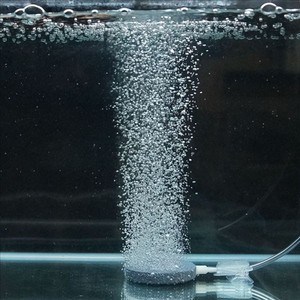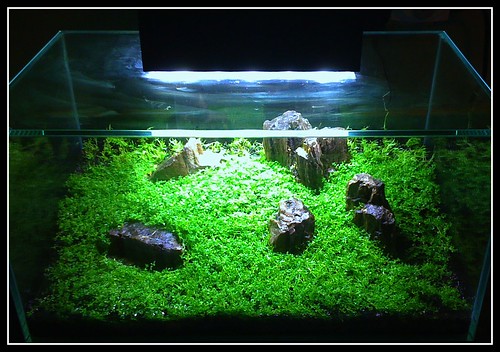I used to have a 29 gallon set up with a couple of large spotted lace catfish and a male betta, and a separate 5 gallon with a single male Malawi golden cichlid (African cichlids don’t mix with anything; they’re vicious little killers). It’s been a few years since I’ve had either up and running, but I still remember some of the important bits.
Salt water is pretty much out of the question. 6 gallons is simply too small for anything but shrimp, sea horses, anemones, or other very small things that don’t move around much. Salt water is also terribly expensive to start out in. It’s also very high maintenance. And the fish are very expensive. Add it all up, and one small mistake could cost you hundreds of dollars (or euros) in fish.
Fresh water fish are much easier. You’ll need to cycle the tank for about one week before you try to populate it. Cycling it means buying one very small fish, like a minnow or a small gold fish, and giving it free run of the take. This builds up ammonia (which is toxic to fish) and starts a culture of nitrifying bacteria on everything inside the tank. These bacteria turn the ammonia into nitrite (which is slightly less toxic to fish) and starts a second culture of nitrifying bacteria. Those bacteria turn the nitrite into nitrate (which is reasonably harmless to fish but great for live plants). There are also tank additives you can buy to jump-start those bacteria cultures. Most new tanks fail because people put too many fish in before the bacteria cultures are large enough to keep the ammonia and nitrite down below toxic levels.
Most people also overload their tanks. Tropical freshwater can support approximately 1 inch of fish per 24 square inches of surface area (not per liter or gallon like many pet stores will say). If your tank has 360 square inches of surface area (fully exposed to the air for CO2/O2 gas exchange) then it can reasonably support up to 15 inches of fish. Cold water requires roughly 30 square inches per 1 inch of fish.
You’ll also need to change 25% of the water once a week. You can stretch it to every two weeks, but never remove more than a third of the water in the tank. Never use any cleaners on the inside or outside of the tank. Buy yourself an algae brush and use it before you change the water. Live plants will help keep the algae under control, but they won’t eliminate it. Keep your tank out of direct sunlight or algae will take over. Snails will eat algae, but they’ll also eat your fish if they can catch them. Snails also reproduce worse than rabbits; once you have them you’ll probably never get rid of them. Your tank is probably too small for an algae eating fish, so don’t bother. Plecostomus (a kind of algae-eater) start small but can get over 2 feet long.
Vacuum out the gravel to get rid of all the fish poop and uneaten food. Shrimp can help keep things clean, but they get eaten by fish and each other. You’ll still need to vacuum the gravel even with shrimp (be careful not to vacuum the shrimp up). A gravel vacuum will clean out the gravel and empty the water from the tank all in one go.
Don’t overfeed your fish. This is probably the biggest mistake after overpopulating. Fish will eat as long is food is available. Gold fish have been shown to literally eat themselves to death. They don’t need to eat every day, and they don’t need to eat more than once a day. I fed my fish 3 times a week, in the morning on Monday, Wednesday, and Friday, and I had those fish alive and healthy for years. Give your fish 5 minutes to eat, then remove anything they don’t eat. That’s all they need.
And turn the light off at night. Fish need day and night cycles like everyone else.










